A pedalboard is a piece of equipment used by musicians to organize and connect multiple effects pedals. Effects pedals are electronic devices that alter the sound of an instrument, and they can range from simple volume and tone controls to complex digital processors. A pedalboard helps musicians manage and use these pedals efficiently, allowing them to create complex soundscapes and express their musical ideas more effectively.
The concept of using effects pedals to modify the sound of musical instruments dates back to the 1960s, when guitarists like Jimi Hendrix and Eric Clapton began experimenting with distortion, delay, and other effects to create new sounds and textures. As the use of effects pedals became more popular, musicians began to realize that connecting multiple pedals together in a chain could create even more interesting and diverse sounds. However, managing all of these pedals can be challenging, which is where the pedalboard comes in.
A typical pedalboard consists of a flat surface made of wood or metal, with a series of holes or slots that allow musicians to mount their effects pedals securely. The pedals are connected together using patch cables, which are short cables designed specifically for this purpose. These cables typically have 1/4-inch plugs on both ends, which are the same type of plugs used to connect guitars and other instruments to amplifiers.
The layout of the pedals on a pedalboard is important, as it can affect the sound quality and usability of the pedals. Some musicians prefer to arrange their pedals in a specific order, such as putting distortion pedals before delay pedals in the signal chain, while others prefer a more random or intuitive arrangement. The size of the pedalboard can also vary, depending on the number of pedals a musician wants to use.
One of the main advantages of using a pedalboard is that it allows musicians to easily switch between different pedals during a performance. This is important because different songs or musical styles may require different types of effects, and switching between pedals manually can be time-consuming and disruptive. With a pedalboard, musicians can simply step on a footswitch or press a button to activate or deactivate a particular pedal, allowing them to focus on playing music rather than tweaking their effects.
Another advantage of using a pedalboard is that it helps to reduce the amount of noise and signal degradation that can occur when using multiple pedals. This is because each pedal in the chain can potentially add noise or alter the signal in some way, which can negatively impact the overall sound quality. By using a pedalboard and high-quality cables, musicians can minimize these issues and ensure that their sound remains clear and consistent.
Pedalboards can also be customized to suit the needs and preferences of individual musicians. Some pedalboards come with built-in power supplies, which can provide clean and stable power to the pedals and eliminate the need for individual power adapters. Other pedalboards may include features like built-in expression pedals, MIDI controllers, or even built-in digital effects.
In addition to guitarists, many bassists, keyboardists, and other musicians also use pedalboards to modify their sounds. Some musicians even use multiple pedalboards for different musical contexts, such as a smaller board for solo performances and a larger board for studio recording or live shows.
Overall, a pedalboard is an essential tool for any musician who wants to explore the creative possibilities of effects pedals. By organizing and connecting multiple pedals together, musicians can create complex and unique sounds that would be impossible to achieve with a single pedal. Whether you’re a seasoned professional or just starting out, a pedalboard can help you take your music to the next level.
In addition to the basic features of a pedalboard described above, there are several other aspects of pedalboards that are worth exploring.
One important consideration is the type of pedals that can be used with a pedalboard. While most effects pedals can be used on a pedalboard, some pedals may require specific power supplies or have unusual sizes or shapes that make them difficult to mount. It’s important to research which pedals are compatible with a particular pedalboard before making a purchase.
Another important aspect of pedalboards is the type of cables used to connect the pedals. While patch cables are the most common type of cable used on pedalboards, there are also other types of cables that can be used to connect pedals. For example, some musicians may use longer instrument cables to connect pedals that are located further apart on the board, while others may use specialized cables like stereo or balanced cables to achieve specific effects.
The power supply used to power the pedals on a pedalboard is another important consideration. Most pedalboards require a DC power supply to provide power to the pedals, and some pedalboards come with a built-in power supply that can provide power to multiple pedals simultaneously. Other options include individual power supplies for each pedal or battery power for pedals that do not require a lot of power.
In addition to the basic components of a pedalboard, there are also several accessories and add-ons that can enhance the functionality of a pedalboard. For example, some musicians may use a pedalboard case or bag to protect their pedals during transportation, while others may use a pedalboard riser to elevate the pedals for better accessibility. Other accessories include cable organizers, pedalboard lights, and pedalboard switching systems.
Finally, it’s worth noting that there are many different types of pedalboards available on the market, each with its own unique features and benefits. Some pedalboards are designed for specific types of musicians or musical genres, while others are designed for versatility and flexibility. When choosing a pedalboard, it’s important to consider factors like the size of the board, the number and types of pedals that will be used, and the specific features and accessories that are important to you as a musician.
Overall, a pedalboard is an essential tool for any musician who wants to experiment with different sounds and effects. By organizing and connecting multiple pedals together, musicians can create unique and complex sounds that would be impossible to achieve with a single pedal. Whether you’re a guitar player, bassist, keyboardist, or any other type of musician, a pedalboard can help you unlock new creative possibilities and take your music to the next level.


